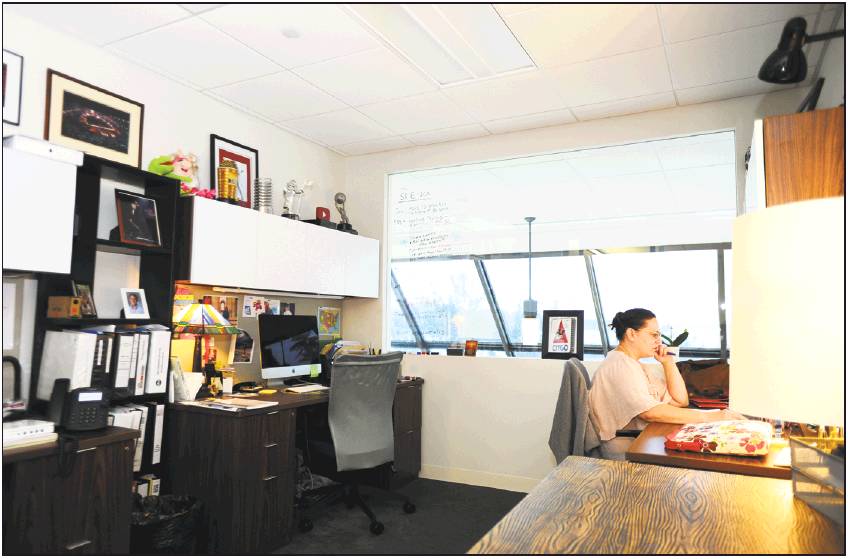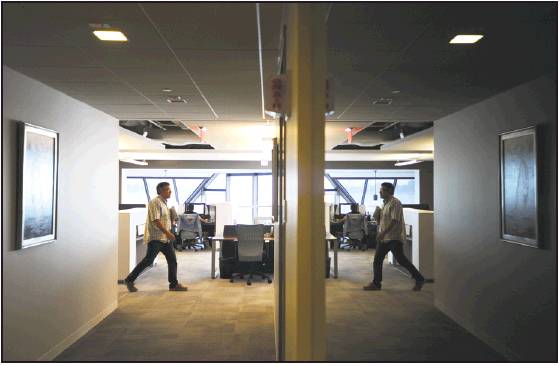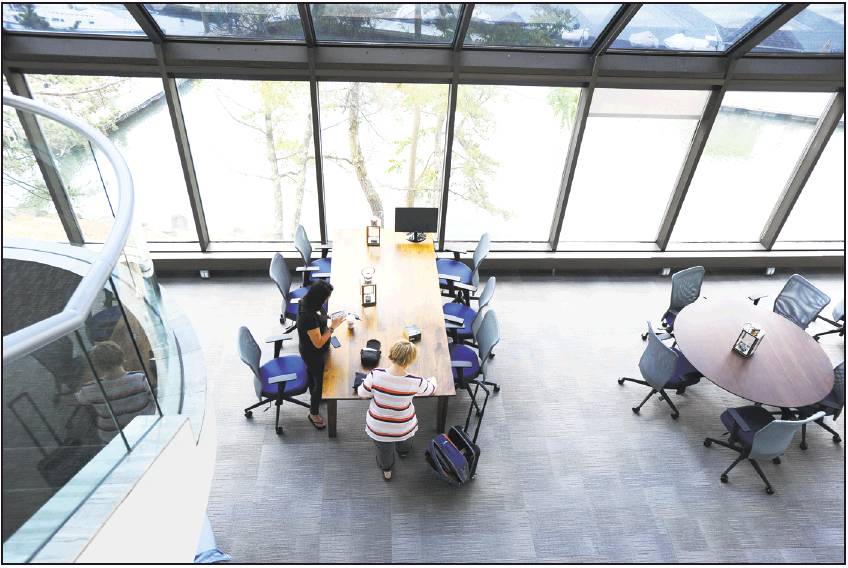DEVELOPMENT
City vies for status as region’s tech hub
Stamford officials looking to startups and IT companies
By Nora Naughton
STAMFORD — When Jeffery Kay and his team from Workpoint began looking for a site for their coworking space, a spot nestled on the harbor in the city’s Shippan Landing felt reminiscent of Google’s campus in Northern California.
“There are some people who want to be steps away from the train,” said Kay, Workpoint’s marketing director and studio supervisor. “But we’re trying to build a tribe of collaborators, and there is a real ecosystem out here with trails, a beer garden and a cafe.”
Companies like Workpoint, which rents space at its waterside offices to startup companies and small business operators, are representative of a larger cultural shift brewing in Stamford.
The hip and collaborative ambience at Workpoint is fostering an organic framework for the city’s plans to become a hub for startup and tech companies, according to Stamford economic development chief Thomas Madden.
“What was traditionally our roots within Stamford is rapidly changing over the last five years,” Madden said. “What we’re really looking at is the information revolution, and we need to be getting Stamford ready for this.”
Madden and the Stamford Partnership, a quasi-public organization aimed at improving living and working conditions in the city, are pushing to create a municipal high-speed internet network as well as traffic patterns with the ability to accommodate driverless or semi-autonomous vehicles — in a bid to attract digitally focused businesses.
“What we’re really looking at is the information revolution, and we need to be getting Stamford ready.”
Thomas Madden, Stamford economic development chief
Even without these improvements, Jackie Light-field, executive director of the Stamford Partnership, said the shift is already happening. Tech companies and other startups are drawn to Stamford because of its proximity to venture capital firms in New York City.
“There are only two tier-one cities in terms of getting access to venture capital if you’re hoping to do a startup or a tech company, and that’s San Francisco and New York,” Light-field said.
While there is some competition between Stamford and neighboring municipalities like Norwalk and New Haven to win the “tech hub” title along the Long Island Sound corridor, Lightfield said what is good for Connecticut as a whole will be good for Stamford as well.
“The agrarian roots of 169 municipalities trying to compete with each other still runs a little strong, but five years from now we are going to be a lot more concerned about what’s happening in the rest of the Northeast corridor than what our differences are between towns,” she said.
For Workpoint, access to venture capital was second to the waterfront landscape and existing digital media infrastructure.
“A lot of it has to do with geography,” said Sheelah Quinn, Workpoint’s sales and events manager. “We are located in a beautiful area that is conducive to creative thinking and inspiring productivity, but one of the things that drew us to Stamford specifically was a long and storied history of broadcasting.”
Workpoint has its own fully equipped recording studio that is often used by its tenants for various video-related projects. It also rents the studio as a space to conduct satellite television interviews.
Thomas Rutledge, CEO of Charter Communications, recently used Work-point’s recording studio to make his announcement on CNBC about the company’s $71 billion acquisition of Time Warner Cable.
Ahead of the curve
To keep tech-oriented tenants in Stamford even after they outgrow their co-working spaces, Madden and Lightfield want to increase the city’s access to gigabit fiber technology.
Gigabit-based internet is a newer and faster broadband service. It is delivered over fiber optic lines and provides speeds of up to 1,000 megabits per second. Workpoint and other operations in the city like NBC Sports that rely on access to high-speed internet have already begun implementing their own gigabit fiber technology.
The next step, Lightfield said, will be to implement a citywide gigabit-level internet service to the residential and the small business commercial corridors.
“We know that the investment into gigabit fiber in Stamford will attract the tech companies and people who create companies here because high-speed internet access is an essential piece of infrastructure,” Light-field said.
One of the reasons GE cited for leaving its Fairfield headquarters of 42 years in favor of Boston was to be at “the center of an ecosystem” with “a technologically fluent workforce.” CEO Jeff Immelt stressed the importance of bandwidth as the industrial giant moves toward a more digitally focused future.
Launching citywide gigabit access will be the “backbone for the future of Stamford,” Madden said.
Autonomous vehicles
Stamford is developing an autonomous car plan that will position the city to be among the first early adopters of this technology.
A more detailed plan is expected to be presented by the end of the summer, but Madden said implementation of gigabit access is a key component of creating an environment that accommodates autonomous vehicles.
He is working with Frontier to launch the necessary internet speeds for the autonomous car plan.
The plan would include a series of traffic infrastructure improvements designed to accommodate self-driving or partially autonomous vehicles.
“We’re invested in becoming the kind of community that embraces updating civic infrastructure that is focused on 20th-century technology,” he said.
The updates connected to the autonomous vehicle project would turn Stamford’s downtown and commercial corridors into actual information highways.
Lightfield said she wants to implement sensor-based technology that would link autonomous vehicles to the city’s traffic infrastructure. Possible updates include remote sensors on parking garages and street lights that would direct traffic flow based on data shared between the vehicles and the infrastructure.
At the state level, there is a race to implement and develop autonomous technology. Nevada was the first state to allow fully autonomous vehicles in 2011. Since then, five other states and Washtington, D.C., have joined the list of states to pass autonomous vehicle legislation.
At the University of Michigan, an autonomous vehicle proving ground called M City allows researchers to develop and test autonomous technology without using public roads.
Lightfield said Stamford is well-equipped to consider a similar development.
“We’re lucky that we have access to so many university pipelines in Stamford,” Lightfield said. “The types of innovation that you see with autonomous cars and the technology that goes into that often comes from university-level research.”
Madden said his department is now focusing on identifying “a concentrated area that would allow innovation to happen.” He said the most useful areas would be Stamford’s downtown and near the train station.
Lifestyle
Infrastructure updates like gigabit and autonomous vehicle technology have become more of a necessity and less of a luxury, according to Madden.
“When we talk to the types of companies we want to attract here, they’re going to look at Stamford and ask, ‘is this a city that embraces my lifestyle and doing everything off my phone?’ ” he said. “We’re making progress, but often it’s with the little things that don’t always make the big splash.”
In addition to millennial-oriented work environments like Workpoint, Madden also cited Commons Park in the city’s growing Harbor Point development in the South End as lifestyle attractions for the tech industry’s hip workforce.
Lightfield said more can be done to cultivate that lifestyle, which at its core is collaborative and social.
“One of the things we’d like to see more of in Stamford is coffee shops,” she said. “Having coffee shops with outdoor seating allows more people to have impromptu meetings and chat about what’s going on.” nora.naughton@scni.com; twitter.com/noranaughton



